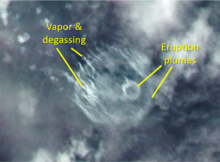Submarine volcano

- Water vapor cloud
- Water
- Stratum
- Lava flow
- Magma conduit
- Magma chamber
- Dike
- Pillow lava


Submarine volcanoes are underwater vents or fissures in the
Hydrothermal vents, sites of abundant biological activity, are commonly found near submarine volcanoes.
Effect of water on volcanoes
The presence of water can greatly alter the characteristics of a volcanic eruption and the explosions of underwater volcanoes in comparison to those on land.
For instance, water causes magma to cool and solidify much more quickly than in a terrestrial eruption, often turning it into volcanic glass. The shapes and textures of lava formed by submarine volcanoes are different from lava erupted on land. Upon contact with water, a solid crust forms around the lava. Advancing lava flows into this crust, forming what is known as pillow lava.
Below ocean depths of about 2,200 metres (7,200 ft) where the pressure exceeds the
The critical temperature and pressure increase in solutions of salts, which are normally present in the seawater. The composition of aqueous solution in the vicinity of hot basalt, and circulating within the conduits of hot rocks, is expected to differ from that of bulk water (i.e., of sea water away from the hot surfaces). One estimation is that the critical point is 407 °C (765 °F) and 29.9 MPa, while the solution composition corresponds to that of approximately 3.2% of NaCl.[4]
Research
Scientists still have much to learn about the location and activity of underwater volcanoes. In the first two decades of this century, NOAA's
Research from the ROV KAIKO off the coast of Hawaii has suggested that pahoehoe lava flows occur underwater, and the degree of the submarine terrain slope and rate of lava supply determine the shape of the resulting lobes.[5]
In August 2019, news media reported a large
Seamounts
Many submarine volcanoes are
Identifying types of eruptions by sounds

There are two types of sound generated by submarine eruptions: One created by the slow release and bursting of large lava bubbles, while quick explosions of gas bubbles create the other one. Using this method to be able to distinguish the two can help measure the related affects on marine animals and ecosystems, the volume and composition of the lava flow can also be estimated and built into a model to extrapolate potential effects.
Scientists have connected sounds to sights in both types of eruptions. In 2009, a video camera and a hydrophone were floating 1,200 metres (3,900 ft) below sea level in the Pacific Ocean near Samoa, watching and listening as the West Mata Volcano erupted in several ways. Putting video and audio together let researchers learn the sounds made by slow lava bursting and the different noises made by hundreds of gas bubbles.[10][11]
See also
References
- ^ ISBN 978-1-4051-2699-1.
- ^ Venzke, E., ed. (2013). "Holocene Volcano List". Global Volcanism Program Volcanoes of the World (version 4.9.1). Smithsonian Institution. Retrieved 18 November 2020.
- ^ Venzke, E., ed. (2013). "How many active volcanoes are there?". Global Volcanism Program Volcanoes of the World (version 4.9.1). Smithsonian Institution. Retrieved 18 November 2020.
- ^ Michael E. Q. Pilson, "An Introduction to the Chemistry of the Sea", 2nd edition. Cambridge University Press, 2013.
- ISSN 0091-7613.
- ^ Guardian Staff (2019-08-25). "Massive pumice 'raft' spotted in the Pacific could help replenish Great Barrier Reef". the Guardian. Retrieved 2021-03-19.
- ^ a b "Satellite Sleuthing Detects Underwater Eruptions". Eos. 31 March 2020. Retrieved 2021-03-19.
- ^ Nybakken, James W. and Bertness, Mark D., 2005. Marine Biology: An Ecological Approach. Sixth Edition. Benjamin Cummings, San Francisco
- ^ "Scientists Discover and Image Explosive Deep-Ocean Volcano". NOAA. 2009-12-17. Retrieved 2009-12-19.
- ^ Scientificamerican.com 2015-04-22 Undersea Volcano Explodes as Scientists Watch
- .
External links
- Volcano Information from the Deep Ocean Exploration Institute, Woods Hole Oceanographic Institution
- Volcano World - now maintained by the Department of Geosciences at Oregon State University
- Britannica - Submarine Volcanoes
- United States Geological Survey
- Ring of Fire Exploration Mission



